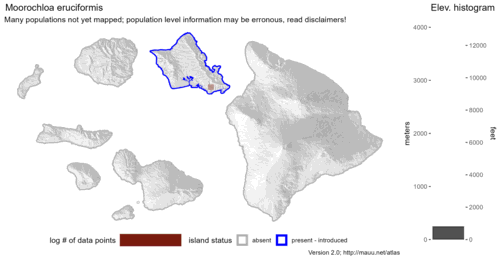Info
Subfamily: Panicoideae
Genus etymology: Moorochloa = "dumb grass" [Greek]. Named in response to the Nomenclatural Committee of the International Association of Plant Taxonomists failure to conserve the prior name
Species etymology: eruciformis = "caterpillar carrying" [Latin] refering to the inflorescence resembling caterpillars
Photosynthetic type: C4 (warm season)
Nativity: naturalized - accidental
First recorded in Hawaiʻi: 2023
Legal status: HDOA - noxious weed
Map

Inflorescence

Habit

Spikelets




Description
Loosely tufted annual; culms 10–60 cm. high, slender, geniculately ascending. Leaf-blades linear to narrowly lanceolate, 2–15 cm. long, 2–6 mm. wide, glabrous or pubescent. Inflorescence of 3–14 racemes on an axis 1–8 cm. long; racemes 0.5–2.5 cm. long, secund, bearing single spikelets imbricate on a triquetrous rhachis. Spikelets elliptic, 1.7–2.7 mm. long, pubescent (rarely glabrous or villous), subacute; lower glume a tiny scale 0.2–0.5 mm. long (up to 1/5 the length of the spikelet); upper lemma readily deciduous, smooth, shiny, obtuse.
(Description source: Clayton, W.D. & Renvoize, S.A. 1982. Flora of Tropical East Africa. Gramineae (Part 3). A.A. Balkema, Rotterdam. 448 pp. )
Annual up to 60 cm high, slender, geniculately ascending; leaves linear to narrowly lanceolate, glabrous or pubescent. Inflorescence of 3–14 racemes on an axis 1–8 cm long; racemes 0.5–2.5 cm long, secund, bearing single spikelets imbricate on a triquetrous rhachis. Spikelets elliptic, 1.7–2.7 mm long, pubescent, subacute, without a stipe; lower glume up to 1/5 the length of the spikelet; upper glume adjacent to the lower; upper lemma readily deciduous, smooth and shining, obtuse.
(Description source: Cope, T.A, (1995) Flora Somalia, Vol 4. Royal Botanical Gardens, Kew, London. 312 pp. )
Loosely tufted annual. Culms 10–60 cm. high, geniculately ascending. Inflorescence of 3–14 racemes, these 0.5–2.5 cm. long, bearing single spikelets on a triquetrous rhachis, sometimes with a secondary racemlet at the base. Spikelets 1.7–3 mm. long, pubescent (very rarely glabrous), subacute. Inferior glume a tiny scale up to 1/5 length of spikelet. Superior floret readily deciduous, its lemma smooth, shiny and obtuse.
(Description source: Launert, E. & Pope, G.V. (eds.). 1989. Flora Zambesiaca. Volume 10. Part 3. Kew, London. 152 pp. )
Plants mat-forming. Culms (10)19–60 cm, decumbent, rooting at the lower nodes before geniculately ascending, sometimes branching from the upper nodes; nodes pubescent; internodes glabrous. Sheaths glabrous or pubescent; ligules to 1 mm; blades 2–6(12) cm long, 3–6 mm wide, pubescent (rarely pilose) on both surfaces, bases subcordate. Panicles 4–9 cm long, 0.5–1 cm wide, exserted, with 3–15 erect to appressed branches; branches 1–2 cm, hispidulous; pedicels 0.1–0.5 mm, pubescent. Spikelets (1.6)2–2.6 mm long, 0.8–1 mm wide, ovate. Lower glumes 0.3–0.5 mm, to 1/5 the spikelet length; upper glumes (1.6)2–2.5 mm; lower lemmas longer than the paleas, 5-veined, without cross-venation; upper lemmas (1.4)1.7–1.8 mm long, 0.6– 0.9 mm wide; anthers 0.5–1 mm, reddish. Caryopses 1–1.5 mm. 2n = 18, 36.
(Description source: Barkworth, M.E., Capels, K.M., Long, S. & Piep, M.B. (eds.) 2003. Flora of North America, north of Mexico. Volume 25. Magnoliophyta: Commelinidae (in part): Poaceae, Part 2. Oxford University Press, New York. 783 pp http://floranorthamerica.org/Moorochloa_eruciformis )